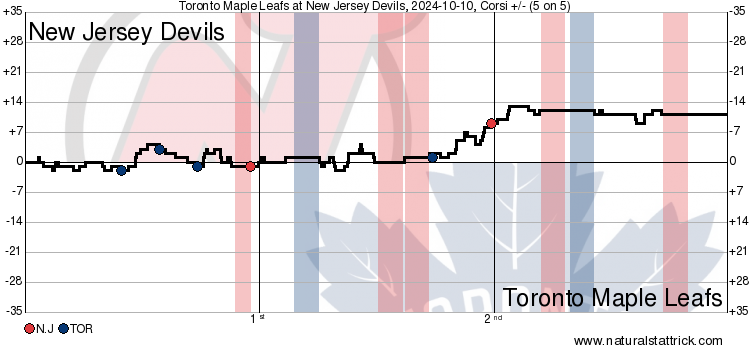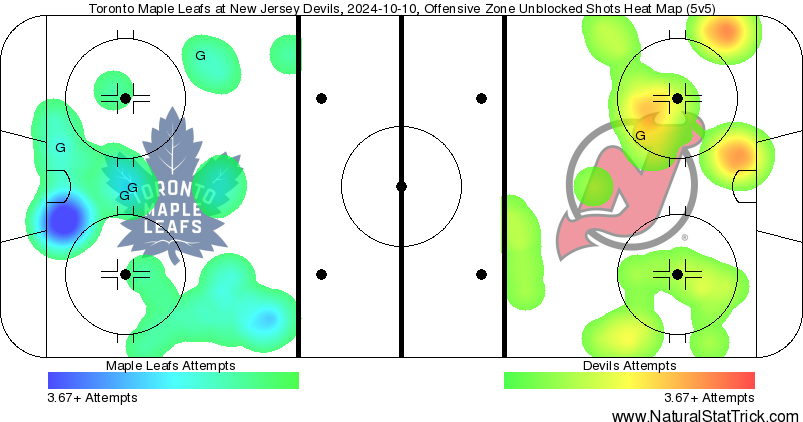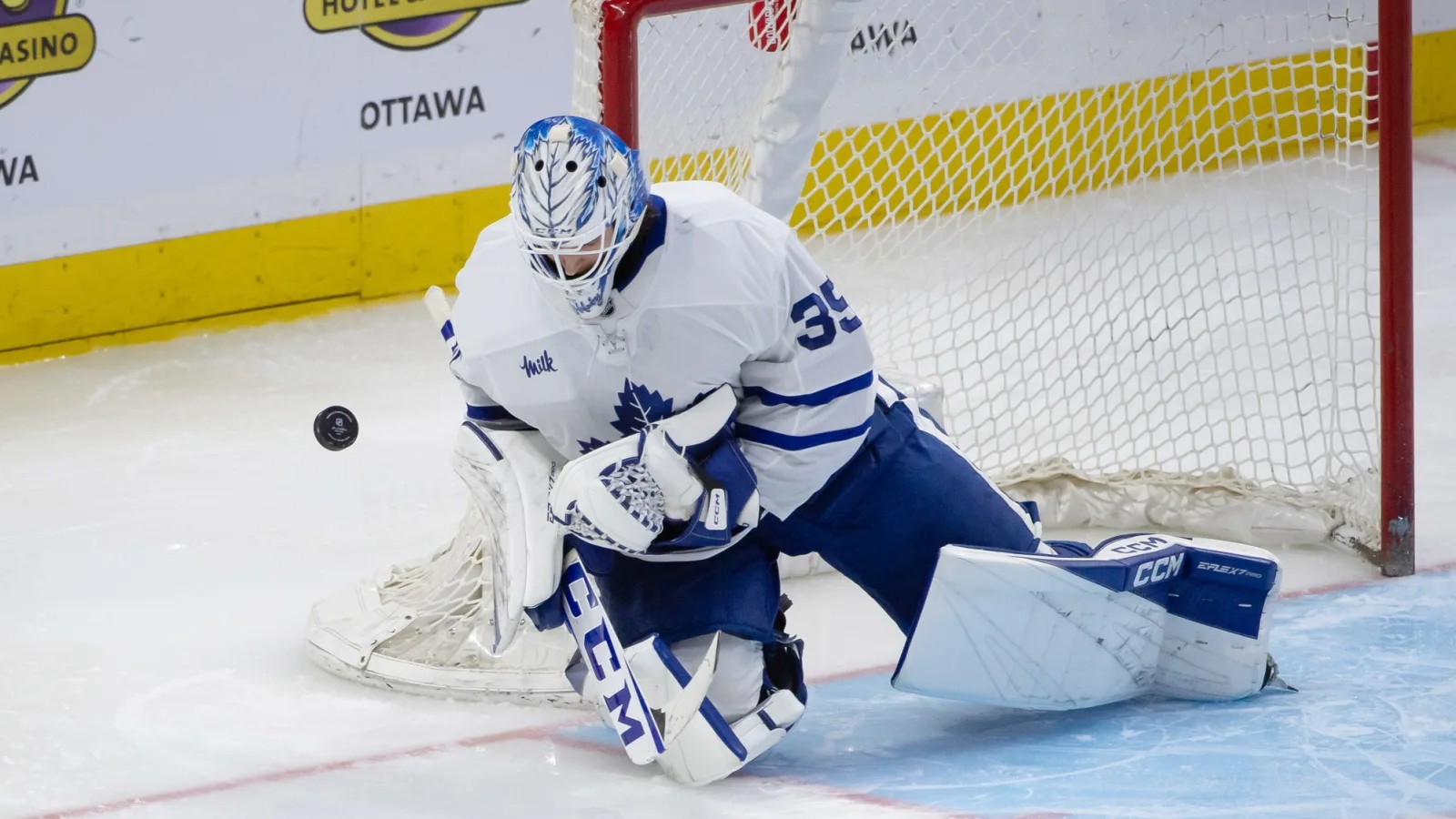Welcome to the real NHL, Sheldon Keefe.
Despite a back-to-back with travel to start, missing their starting goalie, and playing a rookie in the net, the Maple Leafs managed to dig in and pull out a regulation win, spoiling the Devils’ home opener.
Over the years, the Leafs have rarely won games when their top guys haven’t driven the bus, but they did tonight. Their bottom six drove the offense, their defense was solid, Dennis Hildeby played a strong first NHL game, and their penalty kill managed to dig in after giving up an early goal.
Your game in 10:
1. Like in the first game, Craig Berube came out looking to set the tone by starting his top line for the opening faceoff. There was one notable adjustment, though; instead of the Morgan Rielly – Chris Tanev pairing starting with the top line, it was Oliver Ekman-Larsson – Jake McCabe.
Both pairings were really good in the first game, but the Rielly – Tanev pair was presumably used to better support the John Tavares line and help it break out a bit cleaner, which is what happened. It’s an interesting use of the defensive pairings to help drive the forward lines in front of them, especially as the second line struggles a bit defensively with Max Domi and William Nylander on the wings, not to mention an aging Tavares at center.
The first quarter of the period saw both teams feel out the game except when the Leafs‘ third line came on, as Nick Robertson instantly looked to attack and put a few shots on net. Shortly afterward, Auston Matthews hit yet another post.
Finally, the Leafs broke through a few minutes later when Robertson gained the zone and tried to split the defense. He nearly pulled it off but got hauled down in the process, and Max Pacioretty supported the play by winning the battle on the wall back to Robertson. Robertson passed it to the point to Conor Timmins, who did what he does well: get shots through traffic.
Pontus Holmberg drove the net — an important contribution, as it tied up the closest New Jersey defender — and Pacioretty waited out a bouncing puck in traffic to shoot his first as a Leaf into the net.
Pacioretty 1st of the Season vs Devils courtesy of @Bonsie1951 and @Jim_Ralph. @LeafsJelly pic.twitter.com/uEqktHiSwH
— Maple Leafs Hotstove (@LeafsNews) October 10, 2024
It’s the type of battle and bounce that didn’t go the Leafs‘ way in the first game. Craig Berube will love to see it — a good example of a point shot and driving the net to score a goal.
2. A few minutes later, the Leafs doubled their lead courtesy of their other bottom-six line.
Following another good shift from the third line, Steven Lorentz maintained possession, got the puck back in deep, and rimmed it to the far wall, where the puck found Jake McCabe at the blue line. Even though he’s a lefty playing the right side, McCabe has become very good at picking pucks up off the wall and making plays. This time, he brought it to his forehand, spun, and made a little backhand pass off the wall to Bobby McMann, who had tons of time and space.
McMann could’ve walked in, but he quickly shot the puck, and the suddenness of the shot — coupled with a Devils defenseman skating by Markstrom — seemed to throw the New Jersey goaltender off. The puck got through to make it 2-0, and it’s a nice confidence booster for McMann after a healthy scratch to start the season.
"I'LL SHOW YOU SOME GOAL SCORING!"
McMann 1st of the Season vs Devils courtesy of @Bonsie1951 and @Jim_Ralph. @LeafsJelly pic.twitter.com/reqr37ZqNM
— Maple Leafs Hotstove (@LeafsNews) October 10, 2024
In preseason, McMann played a good first game but otherwise didn’t stand out. To me, he had enough clout to be a lineup lock — Brad Treliving called him a top-six forward! — and the Leafs are going to need him. Hopefully, this settles McMann into the lineup and builds some grace with Berube.
3. The Leafs’ fourth line played a good game in Montreal, and now, with McMann in for Reaves, they had a really good game, adding a third goal.
Steven Lorentz, once again, was the first man in on the forecheck and won the race to the puck behind the net before cycling it back to David Kampf. Kampf tried to take the puck in front, but it got poked off his stick to the slot, where Bobby McMann skated through (coming down the ice from the bench). Even though McMann missed, it drew in a defender, and the puck laid in the slot for Lorentz (who started the play). Lorentz jumped on the puck and fired a backhand that fooled Markstrom.
Lorentz 1st of the Season vs Devils courtesy of @Bonsie1951 and @Jim_Ralph. @LeafsJelly pic.twitter.com/D8YpDZN8u1
— Maple Leafs Hotstove (@LeafsNews) October 10, 2024
It was a nice reward for Lorentz, who has been very effective through two games so far. His size and speed leap off the page. He’s winning a ton of battles and disrupting plays with his length, and he now has two points through two games as a Leaf.
4. Up 3-0, the Leafs were managing the game and controlling play well before a really bad penalty was called. The broadcast didn’t show the replay, but Berube was irate, calling it a dive. I tried to rewind it to watch, and you could see John Tavares, out of the corner of the screen, bump into a player on the backcheck, who went down super easy (likely why Berube was upset).
It sent the Leafs to the penalty kill, where they went with a rotation of Holmberg – Lorentz followed by Matthews – Marner, and it did not go well. The PK was super passive, and the Devils were freely allowed to set it up and create the looks they wanted. When they got the puck to the crease, Holmberg had a chance to clear it, but he wasn’t strong enough on his stick and didn’t get enough on it. The clearing attempt was effectively a pass on the tape to Jesper Bratt, who walked right in and ripped an easy shot for a goal. Dennis Hildeby had no chance.
That’s two straight games to start the season in which the Leafs conceded a power-play goal. The themes of passivity and failure to close down passing lanes are something to monitor.
5. In the second period, the Leafs got their turn to go on the power play, and similar to the game against Montreal, it went really poorly. The best chances were a cross-crease attempt from Tavares to Rielly at the backdoor that didn’t connect and a New Jersey Devils 2v1.
It is early — nobody is going to panic about it just yet — but to reunite the top unit and have it look legitimately bad — hardly even producing chances so far — is difficult to wrap your head around or even accomplish, considering they have been excellent in the regular season for five years.
On the bright side, the fourth line drew the initial penalty, and they also went on a breakaway via David Kampf in the second period, continuing their strong play in the game.
6. Other than the Leafs’ power play, the period and game again felt relatively well managed before the Leafs got into penalty trouble. TSN’s Mike Johnson, who was standing between the benches, made a point of noting how animated penalty-killing coach Lane Lambert was while standing up on the bench. I don’t know if it will make a difference, but it’s good to see some urgency from the staff about this unit right away. Last season, it was generally dismissed until the last 10-15 games, even though it was a problem the entire year.
For the Leafs’ part, there was more urgency this time. David Kampf and Matthew Knies were worked into the rotation as a duo. I’m not sure why Kampf hasn’t been on the penalty kill, but it doesn’t make much sense. The Leafs do not have four penalty killers better than Kampf at forward as of right now. He made a notable difference and got a clear, but the highlight of the kill was Knies absolutely running over Dougie Hamilton and taking it down the ice for a scoring chance.
The Leafs got the kill, and it looked like a good momentum-building moment in the game before the Leafs took another penalty. This kill was a little more chaotic, and Timo Meier just missed what could have been an empty net tap-in backdoor. The Leafs managed to get out of it without conceding, and at this point, they have to take what they can get on the PK.
7. The penalty kill definitely went to the Leafs’ legs. They almost immediately made it 4-1 on a beautiful goal. In training camp, I noted that the Leafs are sending their far-side wingers slashing through the neutral zone for stretch passes. This exact play created the 4-1 goal.
All Oliver Ekman-Larsson did was chip the puck off the glass to the far blue line. Max Domi slashed across, hunted the puck down, gained possession, curled, and put the puck right on John Tavares’ tape in the middle of the ice.
Tavares realized a forward was in front of him defending, made a nice little cut-in move, and then ripped the puck back the other way into the high corner. It was a beautiful finish from Tavares, who can still clearly rip the puck when he’s in a good spot.
Tavares 1st of the Season vs Devils courtesy of @Bonsie1951 and @Jim_Ralph. @LeafsJelly pic.twitter.com/QaoPZ7pLBL
— Maple Leafs Hotstove (@LeafsNews) October 11, 2024
8. In general, it was a strong second period for the Leafs, but once again, they couldn’t close the period cleanly. In the first period, they gave up a power-play goal in the final minute, but this one was far more lucky for the Devils.
The Leafs were controlling play in the offensive zone when the puck went up to the point, where Simon Benoit tried to shoot it, but his stick exploded. The Devils raced up the ice, and the Leafs did well to get back and stop the initial rush, but there was confusion in the defensive zone as Benoit didn’t have a stick and wanted Kampf’s. They were basically standing beside each other as the puck went to the far-side point, where Meier had time to walk in and rip a shot.
It was a bad goal on Dennis Hildeby, as it simply went through him. Otherwise, Hildeby played a really good first game with some excellent saves, but I’m sure he wants the 4-2 goal back.
9. The third period felt generally in control at 5v5, but so far this season, the Leafs have been flirting with a combination of bad penalties and soft officiating.
On one penalty, Matthew Knies took a hard, clean hit and immediately bounced back up. I get what Benoit was trying to do, but it was a clean hit, Knies was fine, and the team was up two. There’s no need to go after Meier (and I love teammates standing up for each other).
Later in the period, William Nylander took a completely senseless penalty after wrapping his hands around Hughes. The infraction was clear as day. Sure, the Devils went down softly, but it was largely unnecessary and avoidable.
The good news for the Leafs is that the penalty kill stood tall. Chris Tanev and Jake McCabe were excellent as a duo, clearing pucks and making all sorts of little plays off the boards to get the pucks up to forwards. David Kampf was worked into the rotation as a regular on the penalty kill instead of Auston Matthews—which is an upgrade—and it made an impact. Steven Lorentz and Pontus Holmberg have generally been solid shorthanded as well.
It’s a work in progress, but this was generally a good showing after the initial goal and something to build on. That said, the Leafs need to stop taking dumb penalties. To close the game, Berube moved Holmberg up with Matthews and Marner, followed by Lorentz in that spot. McCabe-Tanev closed the game, as expected, and were excellent, as expected. Those are a few combinations to keep an eye on moving forward when defending leads.
10. All in all, the Leafs are 1-1-0, and none of Auston Matthews, Mitch Marner, or William Nylander have registered a point. Joseph Woll has yet to play. Some useful players — Jani Hakanpaa, Connor Dewar, and Calle Jarnkrok — have not played yet. Their power play has been putrid, and yet, they should be 2-0-0.
There are plenty of positives to build on—namely, at 5v5, they have been controlling play and winning the scoring-chance battle. This was a solid win that could have been smooth sailing if it wasn’t for the goals conceded at the end of the first and second periods.
Last season, the Leafs started 2-0-0, but Matthews scored a hat trick in both games, and it was firewagon/unserious hockey. I will take learning how to grind and win in this manner, but there’s no doubt that the power play and the big boys need to get going.
Game Flow: 5v5 Shot Attempts

Heat Map: 5v5 Shot Attempts


































